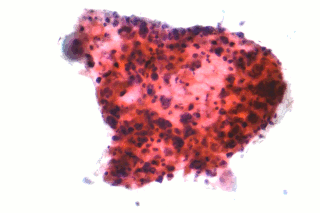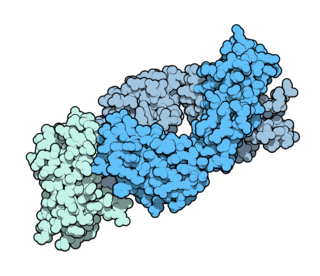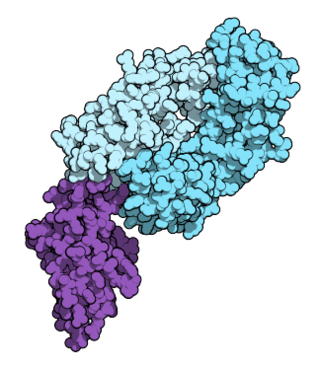Related Research Articles

Gefitinib, sold under the brand name Iressa, is a medication used for certain breast, lung and other cancers. Gefitinib is an EGFR inhibitor, like erlotinib, which interrupts signaling through the epidermal growth factor receptor (EGFR) in target cells. Therefore, it is only effective in cancers with mutated and overactive EGFR, but resistances to gefitinib can arise through other mutations. It is marketed by AstraZeneca and Teva.

The epidermal growth factor receptor is a transmembrane protein that is a receptor for members of the epidermal growth factor family of extracellular protein ligands.
The Center of Molecular Immunology or CIM, is a cancer research institution located on the west side of Havana, Cuba. 23.0755°N 82.4708°W

Non-small-cell lung cancer (NSCLC), or non-small-cell lung carcinoma, is any type of epithelial lung cancer other than small-cell lung cancer (SCLC). NSCLC accounts for about 85% of all lung cancers. As a class, NSCLCs are relatively insensitive to chemotherapy, compared to small-cell carcinoma. When possible, they are primarily treated by surgical resection with curative intent, although chemotherapy has been used increasingly both preoperatively and postoperatively.

Ipilimumab, sold under the brand name Yervoy, is a monoclonal antibody medication that works to activate the immune system by targeting CTLA-4, a protein receptor that downregulates the immune system.
Matuzumab is a humanized monoclonal antibody for the treatment of cancer. It binds to the epidermal growth factor receptor (EGFR) with high affinity. The mouse monoclonal antibody (mAb425) from which matuzumab was developed at the Wistar Institute in Philadelphia, Pennsylvania
Nimotuzumab is a humanized monoclonal antibody that as of 2014 had orphan status in the US and EU for glioma, and marketing approval in India, China, and other countries for squamous cell carcinomas of the head and neck, and was undergoing several clinical trials.

Afatinib, sold under the brand name Gilotrif among others, is a medication which is used to treat non-small cell lung carcinoma (NSCLC). It belongs to the tyrosine kinase inhibitor family of medications. It is taken by mouth.
Treatment of lung cancer refers to the use of medical therapies, such as surgery, radiation, chemotherapy, immunotherapy, percutaneous ablation, and palliative care, alone or in combination, in an attempt to cure or lessen the adverse impact of malignant neoplasms originating in lung tissue.
Targeted therapy of lung cancer refers to using agents specifically designed to selectively target molecular pathways responsible for, or that substantially drive, the malignant phenotype of lung cancer cells, and as a consequence of this (relative) selectivity, cause fewer toxic effects on normal cells.

ALK inhibitors are anti-cancer drugs that act on tumours with variations of anaplastic lymphoma kinase (ALK) such as an EML4-ALK translocation. They fall under the category of tyrosine kinase inhibitors, which work by inhibiting proteins involved in the abnormal growth of tumour cells. All the current approved ALK inhibitors function by binding to the ATP pocket of the abnormal ALK protein, blocking its access to energy and deactivating it. A majority of ALK-rearranged NSCLC harbour the EML4-ALK fusion, although as of 2020, over 92 fusion partners have been discovered in ALK+ NSCLC. For each fusion partner, there can be several fusion variants depending on the position the two genes were fused at, and this may have implications on the response of the tumour and prognosis of the patient.
Angiokinase inhibitors are a new therapeutic target for the management of cancer. They inhibit tumour angiogenesis, one of the key processes leading to invasion and metastasis of solid tumours, by targeting receptor tyrosine kinases. Examples include nintedanib, afatinib and motesanib.
Racotumomab is a therapeutic cancer vaccine for the treatment of solid tumors that is currently under clinical development by ReComBio, an international public-private consortium with the participation of the Center of Molecular Immunology at Havana, Cuba (CIM) and researchers from Buenos Aires University and National University of Quilmes in Argentina. It induces the patient's immune system to generate a response against a cancer-specific molecular target with the purpose of blocking tumor growth, slowing disease progression and ultimately increasing patient survival.

Nivolumab, sold under the brand name Opdivo, is an anti-cancer medication used to treat a number of types of cancer. This includes melanoma, lung cancer, malignant pleural mesothelioma, renal cell carcinoma, Hodgkin lymphoma, head and neck cancer, urothelial carcinoma, colon cancer, esophageal squamous cell carcinoma, liver cancer, gastric cancer, and esophageal or gastroesophageal junction cancer. It is administered intravenously.

Icotinib is a highly selective, first generation epidermal growth factor receptor tyrosine kinase inhibitor (EGFR-TKI). Icotinib is approved for use in China as first-line monotherapy in patients with non-small-cell lung cancer with somatic EGFR mutations.

Dacomitinib, sold under the brand name Vizimpro, is a medication for the treatment of non-small-cell lung carcinoma (NSCLC). It is a selective and irreversible inhibitor of EGFR.

Atezolizumab, sold under the brand name Tecentriq among others, is a monoclonal antibody medication used to treat urothelial carcinoma, non-small cell lung cancer (NSCLC), small cell lung cancer (SCLC), hepatocellular carcinoma and alveolar soft part sarcoma, but discontinued for use in triple-negative breast cancer (TNBC). It is a fully humanized, engineered monoclonal antibody of IgG1 isotype against the protein programmed cell death-ligand 1 (PD-L1).

Osimertinib, sold under the brand name Tagrisso, is a medication used to treat non-small-cell lung carcinomas with specific mutations. It is a third-generation epidermal growth factor receptor tyrosine kinase inhibitor.
YM BioSciences Inc. was a Canadian drug development company primarily focused on advancing CYT-387, an orally administered inhibitor of both the JAK1 and JAK2 kinases, which have been implicated in a number of hematological and immune cell disorders including myeloproliferative neoplasms and inflammatory diseases as well as certain cancers. YM BioSciences also had several preclinical programs underway with candidates from its library of compounds identified through internal research conducted at YM BioSciences Australia.

Amivantamab, sold under the brand name Rybrevant, is a bispecific monoclonal antibody used to treat non-small cell lung cancer. Amivantamab is a bispecific epidermal growth factor (EGF) receptor-directed and mesenchymal–epithelial transition (MET) receptor-directed antibody. It is the first treatment for adults with non-small cell lung cancer whose tumors have specific types of genetic mutations: epidermal growth factor receptor (EGFR) exon 20 insertion mutations.
References
- 1 2 "RESOLUCIÓN No. 2016006539 DE 25 de Febrero de 2016 Por la cual se concede un Registro Sanitario" (PDF). República de Colombia Ministerio de Salud y Protección Social Instituto Nacional de Vigilancia de Medicamentos y Alimentos – INVIMA. Retrieved 28 December 2023.
- 1 2 Crombet Ramos T, Rodríguez PC, Neninger Vinageras E, Garcia Verdecia B, Lage Davila A (2015). "CIMAvax EGF (EGF-P64K) vaccine for the treatment of non-small-cell lung cancer". Expert Review of Vaccines. 14 (10): 1303–1311. doi:10.1586/14760584.2015.1079488. PMID 26295963. S2CID 38130134.
- ↑ Dillow C (8 September 2011). "Cuba Announces Release of the World's First Lung Cancer Vaccine". Popular Science . Retrieved 2011-12-11.
- ↑ Grillo I (23 April 2015). "Cuba has had a lung cancer vaccine for years". GlobalPost . Retrieved 2014-05-24.
- 1 2 3 4 Patel N (11 May 2015). "Cuba Has a Lung Cancer Vaccine—And America Wants It". Wired . Retrieved 2015-05-13.
- ↑ Tamayo H (8 September 2016). "Vacuna contra cáncer de pulmón llega al país". El Tiempo (Colombia) . Retrieved 2016-09-09.
- 1 2 "Cuban anti-cancer vaccines soon to be available in Serbia". Tanjug. October 21, 2015.
- ↑ Yaffe H (2020). We Are Cuba! How a Revolutionary People Have Survived in a Post-Soviet World (hardcover ed.). USA: Yale University Press. ISBN 978-0-300-23003-1.
- ↑ "Can you tell me about the CimaVax lung cancer vaccine?". Cancer Research UK. 12 May 2015. Retrieved 2015-07-02.
- 1 2 3 4 5 6 7 8 9 10 11 Rodríguez PC, Rodríguez G, González G, Lage A (2010). "Clinical development and perspectives of CIMAvax EGF, Cuban vaccine for non-small-cell lung cancer therapy". MEDICC Review. 12 (1): 17–23. doi: 10.37757/MR2010.V12.N1.4 . PMID 20387330.
- ↑ Pérez A, Dickinson F, Cinza Z, Ruíz A, Serrano T, Sosa J, et al. (October 2001). "Safety and preliminary immunogenicity of the recombinant outer membrane protein P64k of Neisseria meningitidis in human volunteers". Biotechnology and Applied Biochemistry. 34 (2): 121–125. doi:10.1042/BA20010029. PMID 11592918. S2CID 27200881.
- 1 2 Neninger Vinageras E, de la Torre A, Osorio Rodríguez M, Catalá Ferrer M, Bravo I, Mendoza del Pino M, et al. (March 2008). "Phase II randomized controlled trial of an epidermal growth factor vaccine in advanced non-small-cell lung cancer". Journal of Clinical Oncology. 26 (9): 1452–1458. doi: 10.1200/JCO.2007.11.5980 . PMID 18349395.
- ↑ Rodriguez PC, Neninger E, García B, Popa X, Viada C, Luaces P, et al. (October 2011). "Safety, immunogenicity and preliminary efficacy of multiple-site vaccination with an Epidermal Growth Factor (EGF) based cancer vaccine in advanced non small cell lung cancer (NSCLC) patients". Journal of Immune Based Therapies and Vaccines. 9 (7): 7. doi: 10.1186/1476-8518-9-7 . PMC 3215653 . PMID 22024351.
- ↑ Saavedra D, Crombet T (2017). "CIMAvax-EGF: A New Therapeutic Vaccine for Advanced Non-Small Cell Lung Cancer Patients". Frontiers in Immunology. 8: 269. doi: 10.3389/fimmu.2017.00269 . PMC 5346887 . PMID 28348561.
- ↑ "Why an American went to Cuba for cancer care". BBC News. 19 April 2017. Retrieved 27 January 2023.
- ↑ Davis H (26 October 2016). "Roswell Park gets go-ahead to test Cuban lung cancer vaccine". The Buffalo News. Retrieved 3 December 2016.
- ↑ "CIMAvax Vaccine and Nivolumab in Treating Patients With Stage IIIB-IV Non-small Cell Lung Cancer - Full Text View - ClinicalTrials.gov". clinicaltrials.gov. Retrieved 2017-04-02.
- ↑ Hoshaw L (2 December 2016). "Cuba Has a Lung Cancer Vaccine; Now U.S. Patients Will Test It". KQED News. Retrieved 3 December 2016.
- 1 2 3 "Roswell Park Lung Cancer Expert Shares Initial Findings From First North American Study of CIMAvax". Roswell Park Comprehensive Cancer Center. September 26, 2018. Retrieved 10 April 2019.
- 1 2 3 "With Safety Analysis Now Complete, Roswell Park Moves Forward With Expanded Study of CIMAvax". Roswell Park Comprehensive Cancer Center. March 30, 2019. Retrieved 10 April 2019.
- ↑ Jain P, Hutson A, Janes C, Bruno DS, Durm GA, Sangal A, et al. (1 June 2023). "Phase 2 trial of epidermal growth factor (EGF) vaccine CIMAvax in combination with pembrolizumab in first line and maintenance setting in advanced non–small cell lung cancer patients". Journal of Clinical Oncology. 41 (16_suppl): TPS2677. doi:10.1200/JCO.2023.41.16_suppl.TPS2677. S2CID 259082182.